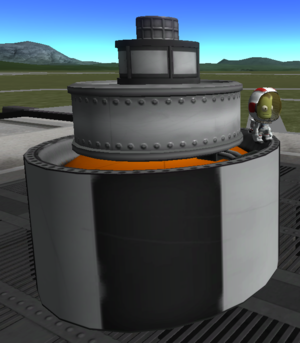Difference between revisions of "Radial size"
(→Rocket: It's modelled after the new NASA SLS, not the old Saturn V. Of course, the SLS is arguably just a major tech-refresh of the Saturn V.) |
m (→Rocket: Also uses Rocketdyne RL10) |
||
| Line 33: | Line 33: | ||
* '''Small / 1.25m.''' The most common size, and the primary size available at the beginning of the game. | * '''Small / 1.25m.''' The most common size, and the primary size available at the beginning of the game. | ||
* '''Large / 2.5m / Rockomax.''' | * '''Large / 2.5m / Rockomax.''' | ||
| − | * '''Extra Large / 3.75m / Kerbodyne.''' Styled after NASA's real-world [[w:Space Launch System|Space Launch System]], which uses Rocketdyne [[w:Space Shuttle main engine|RS-25]] engines. | + | * '''Extra Large / 3.75m / Kerbodyne.''' Styled after NASA's real-world [[w:Space Launch System|Space Launch System]], which uses Rocketdyne [[w:Space Shuttle main engine|RS-25]] and [[w:RL10|RL10]] engines. |
=== Spaceplane === | === Spaceplane === | ||
Revision as of 07:35, 13 June 2015
The radial size is the diameter or mounting position for most parts. If the mounting position is not radial, then the part is either round or one of two special forms. Such rectangular parts as the M-1x1 Structural Panel lack a radial size or it's a size to the next bigger diameter like the Probodobodyne QBE. Four radial sizes exist with varying names. The size scale looks like the internal definition as the Mk2 to size 1 Adapter uses this term and starts with 0 and many values in computer programming are starting from 0 rather than 1.
Any stackable part can be connected to any other stackable part. Matching radial sizes only serves to give a rocket a cleaner visual appearance, and several adapter parts exist to allow transitions between radial sizes while maintaining an unbroken surface.
Sizes
| Radial size | Fuel per m | Typical crash tolerance | Typical maximum temperature | ||
|---|---|---|---|---|---|
| Rocket fuel | Liquid fuel | Monopropellant | |||
| Tiny / 0.625m | 115 | n/a | 213 | 6 m/s | 2000° |
| Small / 1.25m | 213 | n/a | 438 | 6 m/s | 2000° |
| Large / 2.5m / Rockomax | 853 | n/a | 750 | 6 m/s | 2000° |
| Extra Large / 3.125m / Kerbodyne | 1925 | n/a | n/a | 6 m/s | 2000° |
| Mk1 | n/a | 80 | n/a | 20 m/s | 2000° |
| Mk2 | 213 | 213 | 213 | 40 m/s | 2200° |
| Mk3 | 1000 | 1000 | 1000 | 50 m/s | 2300° |
Rocket
The typical mass ratio for rocket fuel is 9.
- Tiny / 0.625m. Typically used for probes and nose electronics.
- Small / 1.25m. The most common size, and the primary size available at the beginning of the game.
- Large / 2.5m / Rockomax.
- Extra Large / 3.75m / Kerbodyne. Styled after NASA's real-world Space Launch System, which uses Rocketdyne RS-25 and RL10 engines.
Spaceplane
Spaceplane parts may carry either rocket fuel or liquid fuel. Compared to rocket parts they tend to have a poorer mass ratio (usually about 8), but better crash tolerance and maximum temperature.
- Mk1. Like the 1.25m rocket size, this size is a cylinder. All inline air intakes are of this size, but there are no rocket fuel tanks.
- Mk2. With its side chines, this spaceplane size is reminiscent of the real-world Lockheed SR-71 Blackbird. It is between the 1.25m and 2.5m sizes in cross-sectional area. These parts feature a small amount of lift.
- Mk3. Reminiscent of the real-world Space Shuttle. The cross-sectional area is similar to the 3.75m rocket size.
Adapters
- 1:1 parts between the same size are not shown.
- Note that all parts can be reversed so a nosecone can serve as a tail and vice versa.
- Fairings (Airstream Protective Shells) can be placed inline and thus serve as adapters as well as nosecones.
Assets
When creating assets, the correct diameter for a desired model can be found in the table below. The "meter scale" refers to the actual model's diameter, which is then typically scaled up via the default rescaleFactor of 1.25, to give the "actual" in-game diameter. Size scale is used to denote the standard when selecting a node size.
| Name | Size scale | Meter scale | Actual size | Example |
|---|---|---|---|---|
| Tiny | 0 | 0.5 m | 0.625 m | Rockomax 48-7S |
| Small | 1 | 1 m | 1.25 m | LV-T30 Liquid Fuel Engine |
| Large | 2 | 2 m | 2.5 m | Rockomax "Mainsail" Liquid Engine |
| Extra large | 3 | 3 m | 3.75 m | Kerbodyne KR-2L Advanced Engine |
As a special radial size Radial mounted appears. Parts like Rockomax 24-77 so lack general metric counterparts as to eliminate confusion.
Non-cylindrical sizes named “Mk2”, and “Mk3” exist and are used by fuselage parts intended for spaceplanes.
Additional sizes
Several addons add additional, usually larger, radial sizes which are roughly following the stock size scale. There are up to 9 meter parts in the B9 Aerospace mod and mods like Tweakscale can scale parts more freely.
